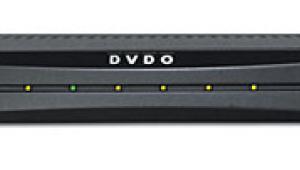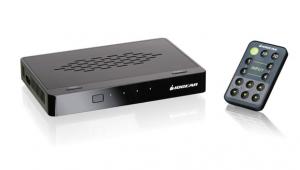Alchemy² D²L Digital Delay Line
None of the above. It's non-synchronized audio and video—the lip sync issue. No, we're not talking about Ashlee Simpson. We're referring to the sound and image being misaligned in time. People on screen start talking before they open their mouths. Explosions are heard before they're seen. The cart, in short, arrives before the horse.
 Riding to the rescue is the D²L, or Digital Delay Line ($400) from Alchemy². Alchemy² is a new company founded by Peter Madnick, the former designer for both Audio Alchemy and Entech (the latter a one-time subsidiary of Monster Cable). While both of those brands are on, um, indefinite hiatus, Alchemy² continues their tradition of providing useful and reasonably priced audio/video niche products—products that other companies seem to have overlooked, or insist on charging premium prices for. The D²L is their first (and so far only) product.
Riding to the rescue is the D²L, or Digital Delay Line ($400) from Alchemy². Alchemy² is a new company founded by Peter Madnick, the former designer for both Audio Alchemy and Entech (the latter a one-time subsidiary of Monster Cable). While both of those brands are on, um, indefinite hiatus, Alchemy² continues their tradition of providing useful and reasonably priced audio/video niche products—products that other companies seem to have overlooked, or insist on charging premium prices for. The D²L is their first (and so far only) product.
The Problem
Some of us rarely experience the program- and playback-dependent lip-sync phenomenon, but for those who do it's like being trapped at a Godzilla film festival. Or a Charlie McCarthy retrospective. Before long you want to turn off the sound and turn on the subtitles. Or read a book.
Lip-sync can originate at either the broadcast or display end. Broadcast problems (including satellite and cable) have been prevalent enough to drive SMPTE (the Society of Motion Picture and Television Engineers) to establish an Ad Hoc group to study the issue.
On the receiving side, both video displays and the scalers and deinterlacers (video processors) we use with them can conspire to delay the image until it is obviously out of sync with the sound. Digital displays sometimes buffer the video before displaying it. Processors can introduce additional delays. While neither of these lags by themselves will always be enough to cause a visible problem, they can add up. A delay of merely one frame results in an image lag of 33.3 milliseconds (at a frame rate of 30fps). This doesn't sound like much, but most viewers can spot it.
What to Do?
While a situation in which the sound actually lags the video is theoretically possible (and would most likely originate at the production end rather than in the playback system), it isn't likely. I know of no consumer devices that will correct for this (they would have to delay the video, not the audio).
The far more common scenario of the lagging picture is a different story. More and more surround pre-pros and AV receivers (and even the occasional DVD player, though this won't help with HD broadcasts) are including adjustable audio delay circuits. They delay all channels equally, unlike the individual channel delays that are part of the initial system setup and calibration. Many of these circuits have a limited range. While a delay of 4 frames (133.3ms) should be sufficient to accommodate any likely mismatch with the video, there might be instances in which you need even more. And there are some older—and otherwise still very good—products that lack this feature entirely.
The Alchemy² D²L fills the gap. It has one function and one function only: to accept a digital input, delay it, and output the delayed digital audio to a digital input on your receiver or pre-pro.
A Quick Look
There is little to describe about either the layout or functionality of the D²L. It has two digital inputs and two digital outputs (in both cases, one is coaxial, the other TosLink), and both outputs are active at all times. Power comes into the unit from a wall-wart transformer. And there's an RS-232 input for use with automated systems or for software updates.
The D²L will handle PCM, Dolby Digital, and DTS program material. It will function with sample rates of 32, 44.1, 48, 88.2, 96, and 192kHz. Most of the video sources you'll want to delay will be at a sample rate of 48kHz. Why would you want to route audio-only program material of say, 96kHz, through the D²L? The only reason I can think of is that the source device is used for both audio-only and video sound, as with a DVD/CD player.
The D²L's front panel offers a bypass switch to eliminate any delay, an input selector that toggles between Input 1 and Input 2, and controls that allow you to set the delay at one of 256 steps (including Bypass). There is also a display window that shows the audio sample rate (briefly, when an input is selected), the input chosen, and, in its normal operating state, the delay setting. And Alchemy² didn't forget the environment in which many D²Ls will be used- the display panel dims automatically a few seconds after the delay indicator appears.
The number that shows in the display window indicating the delay setting is a reference number, not the display time. The actual delay depends on the sample rate. As noted in the brief owner's manual, at a 48kHz sample rate (used for both Dolby Digital and DTS), each step changes the delay by 5.27ms. That means for Dolby Digital, the available delays range up to 1.34 seconds (0.00527 x 255).
In Use
I'm perhaps not in the best position to evaluate a lip sync device, as I rarely have a troublesome lip sync issue in my system. But it was easy enough for me to experiment with delays to see how well the D²L operates by deliberately using it to misalign the audio-video sync.
The D²L was so simple to set up and use that I began, like many of you would, without referring to the instructions. I assumed that the numbers on the front panel were actually milliseconds, so I initially ran the delay all the way up to 255, which I took to be 255 ms.
The soundtrack from Star Trek: Enterprise, which I was reviewing at the time, was now so out of whack in time that one character's lines sounded like they were coming from the next character who spoke. Wow, I thought, they can sure say a lot in a quarter of a second!
 But as I found out in short order from the instructions, that 255 setting was actually 1.34 seconds at the Dolby Digital sampling rate. When I dropped the delay down to an indicated 50 (about 264ms at 48kHz) the lip sync was just bad enough to be readily apparent. When I dropped it down to 20 (about 105 ms at 48kHz) it was, for me, no longer noticeable. Your mileage may vary.
But as I found out in short order from the instructions, that 255 setting was actually 1.34 seconds at the Dolby Digital sampling rate. When I dropped the delay down to an indicated 50 (about 264ms at 48kHz) the lip sync was just bad enough to be readily apparent. When I dropped it down to 20 (about 105 ms at 48kHz) it was, for me, no longer noticeable. Your mileage may vary.
Just remember as a rule of thumb that for most current video sources with a digital soundtrack, the delay, in milliseconds, is approximately five times the number indicated on the display. What this means is that the D²L has more than enough range to match any conceivable video delay, and far more than I've seen offered on any pre-pro or receiver. It does exactly what it is supposed to do.
You can also set different delays for the two inputs, or easily fine tune the delay for different program material. Yikes! I've just discovered the videophile equivalent of an analog LP fan setting a different vertical tracking angle for each recording! In both situations, using a compromise position would be far less tedious.
I did experience one potentially serious problem with our review sample. The first time I touched it, after it had been running flawlessly for an hour or so, the sound immediately cut off, though the front panel display and controls continued to operate. My first thought was a static electricity problem—though there was no obvious static discharge. It took a couple of worried minutes before I was able to re-engage the unit by some random combination of disconnecting the power, re-connecting it, and flipping back and forth between inputs until it locked on again. I was afraid that I'd fried the unit, but it did come back on, good as new.
After I finished the review and was willing to risk another potentially damaging shutdown, I tried touching it again. This time there was a distinct static discharge, and the unit malfunctioned once more. All of its indicators continued to work, as before, but there was, again, no sound. After several minutes I was able to reengage the unit. But it took longer this time and I came very close to giving up on it. After that, I was careful to touch a less sensitive piece of gear—or a nearby metal rack, before touching the D²L. If I did that first, there was no problem.
Subsequent to receiving this review for a fact check, Alchemy² noted that they have not had field reports of a similar static electricity problem. But they also report locating a spot in the circuit where a ground problem could occur in manufacture. They plan to upgrade their QC procedures to prevent such problems in the future, and have offered to send us a second sample. I will append a report on that new sample to this review as soon as possible.
I should also note that I didn't hear any deterioration in the audio from the D²L's delay, even at its maximum. Peter Madnick of Alchemy² argues that some of the delay circuits provided in pre-pros and receivers can compromise the audio. I can't say I've ever experienced that; most of the electronics I've been using have been high-end enough that the manufacturers can include quality delay circuits.
Conclusions
Apart from its apparent sensitivity to static electricity, the D²L works exactly as advertised. It is perhaps a little expensive for the budget-priced electronics that might have the most use for it, but even higher up on the pre-pro or receiver price ladder there are many products that don't offer anywhere near its flexibility. There's very little else like it on the market.
Highs and Lows
Highs
Does the job without any side effects
Extremely wide range of operation at the most common audio-for-video sampling rate
Lows
Sensitive to static electricity.
- Log in or register to post comments


























































